Biomedical and Healthcare Training Package for Beginners, 10 Learning Products
Original price was: $925.00.$308.00Current price is: $308.00. Student Discount
This training package includes 10 practical exercises, using ANSYS Fluent software. MR CFD suggests this training package for all engineers interested in the BIOMEDICAL & HEALTHCARE field, who will learn CFD simulation in this field at the BEGINNER level.
To Order Your Project or benefit from a CFD consultation, contact our experts via email ([email protected]), online support tab, or WhatsApp at +44 7443 197273.
There are some Free Products to check our service quality.
If you want the training video in another language instead of English, ask it via [email protected] after you buy the product.
Description
Biomedical and Healthcare Training Package for BEGINNER ANSYS Fluent Users
Fluids, fluid dynamics, and transport-related phenomena are widespread in medicine and the life sciences. We apply them because of their potential for use as building blocks, components, and subsystems; As well as signaling, power supply, regeneration, and destruction have evolved. In addition, we develop biomedical engineering devices through medical, pharmaceutical, and biological devices. So, we use the same pathways and physical forms to deliver our work product. Work products include catheters, implantable artificial hearts, solutions, and inhaled biological materials.
Hence, understanding and predicting fluid and transport behavior has become a distinct advantage for companies operating in the medical, pharmaceutical, and biology sectors in the life sciences industry. Computational Fluid Dynamics (CFD) is the name of a set of tools for predicting fluid behavior. We use this set of biomedical tools to test stress in pre-sampling design, reduce the volume of laboratory tests with blood and other biological fluids, reduce the need for preclinical tests, and evaluate product performance. CFD simulations in the field of Computational Fluid Dynamics Analysis (CFD) for the life sciences industry using the advanced model definition and analysis software like ANSYS Fluent are carried out with the expertise of the MR CFD team.
Here are some biomedical CFD simulations that engineers can purchase and use as a template for their CFD analysis in various biomedical systems and components as a biomedical CFD Training Package. This CFD training package includes 10 practical Biomedical and Healthcare engineering exercises using ANSYS Fluent software. We suggest this package for all healthcare and biomedical engineers who will learn CFD simulation in this field at the BEGINNER level.
We start this training package with 2 simple practical exercises in the field of blood flow in arterial occlusion and clogged arteries.
Exercise number 1 simulates arterial occlusion considering blood by ANSYS Fluent software. The fluid used in the simulation process is blood, which has a density of 1060 kg.m-3 and a viscosity of 0.35 kg.m-1s-1. The flow rate of the blood flow to the artery from both inlet branches is 0.002385 kg.s-1 and the vessel wall is assumed to be static.
Problem number 2 simulates the blood flow in a clogged artery using ANSYS Fluent software. In this modeling, a number of horizontal vessels are designed in which there is a curved blockage in the middle of the blood flow path. The defined blood flow inside this vessel has a density of 1035 kg.m-3 and a viscosity of 0.0043 W.m-1.K-1.
Then we consider the blood as a Non-Newtonian applying Pulsatile flow by 3 practical exercises.
Training number 3 simulates blood flow within a clogged vessel using ANSYS Fluent software. Fluids are divided into two categories according to their viscosity: Newtonian and Non-Newtonian fluids. Viscosity of a fluid is a parameter that indicates the resistance of that fluid to flow.
In project number 4, unsteady pulsatile blood flow is simulated in an artery bifurcation simplified model by ANSYS Fluent software. The unsteady nature of blood flow is simulated using a User-Defined Function (UDF), which changes the inlet velocity according to flow time as a sinus function. The results show the prone regions of artery wall rupture and stenosis formation.
Problem number 5 deals with the blood flow in a vessel by ANSYS Fluent software. The fluid used in this simulation is blood, which is a non-Newtonian fluid. Non-Newtonian fluids are fluids whose viscosity varies with their reaction rate, meaning they lack a specific viscosity.
After studying the different kinds of blood flow, it is time to investigate the CORONA virus infection through the next 3 practical exercises.
In the practical Exercise number 6, based on the CFD method and using ANSYS Fluent software, an attempt has been made to simulate the release of virus particles from a Coronavirus patient’s mouth while talking and transmitting it to another person in a specific space (social distancing). This study aims to investigate the ability of virus particles to propagate and transmit at a distance less than a social distance. For the present simulation, the discrete phase model (DPM) is used; Because this model allows us to study a mass of particles discretely in a continuously fluid space.
In problem number 7, based on the CFD method and using ANSYS Fluent software, an attempt has been made to simulate the release of coronavirus particles from a patient’s mouth while talking and using a shield (mask) to prevent transmission to another person. The aim of this study was to evaluate the effectiveness of using a shield or mask as a barrier on the face of a patient against the spread of virus particles. Also, for the present simulation, the discrete phase model (DPM) is used.
Simulation number 8 simulates the flow of fresh air through the air conditioning system inside a patient’s room considering the CORONA virus by ANSYS Fluent software. We place the patient on a bed in a room with a high temperature on his body and constantly spreads the CORONA-virus particles by breathing through his mouth into the room’s interior. In fact, the goal is to use an air conditioning system and keep the fresh air flowing continuously inside the room to remove contaminants from the patient’s mouth through the outlet vents, and the room environment should be purified in terms of pollution, and a balanced and pleasant temperature should be provided for the thermal comfort of the patient inside the cleanroom.
Finally, we simulate 2 different case studies of Asthma Spray Inhaler Injection Into the Lung and Hyperthermia Therapy of Biological Tissue.
In training number 9, Asthma Spray in human lungs was investigated using the one-way DPM (Discrete Phase Method) method using Ansys Fluent software. In this simulation, two types of material are used: air and particles that enter the lungs as Discrete phase material. Trajectories of particles within the lung were observed using Ansys Fluent software.
The last study (project number 10) examined blood flow in capillaries passing through a tissue containing cancerous tumors and using Hyperthermia Therapy. For this purpose, we assume a spherical space to be an example of healthy body tissue or cell in which blood flows at a very slow rate. There are several veins within this tissue.
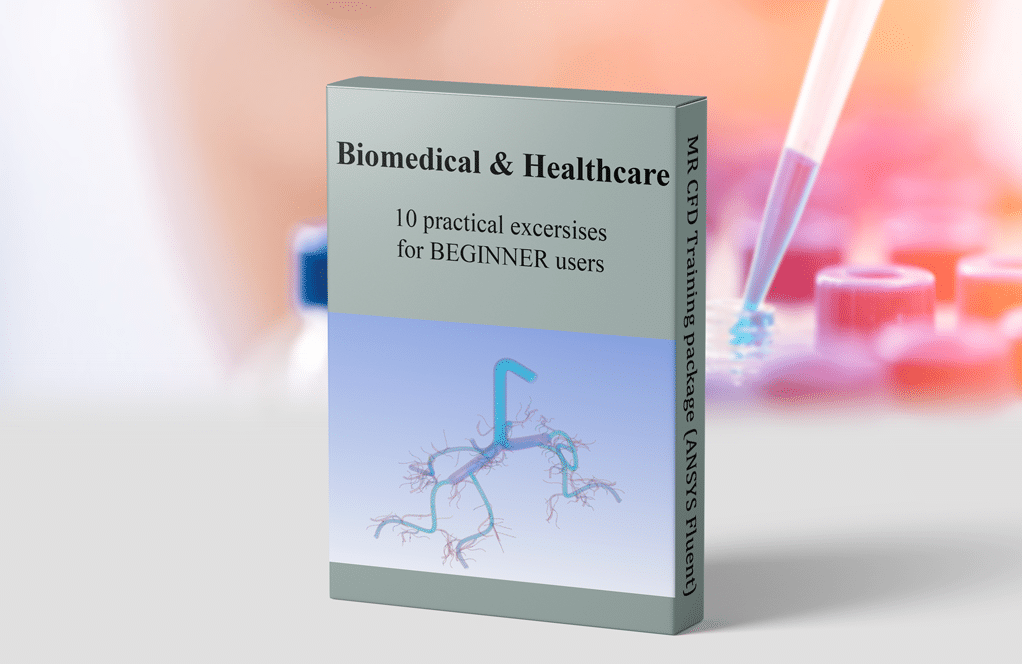








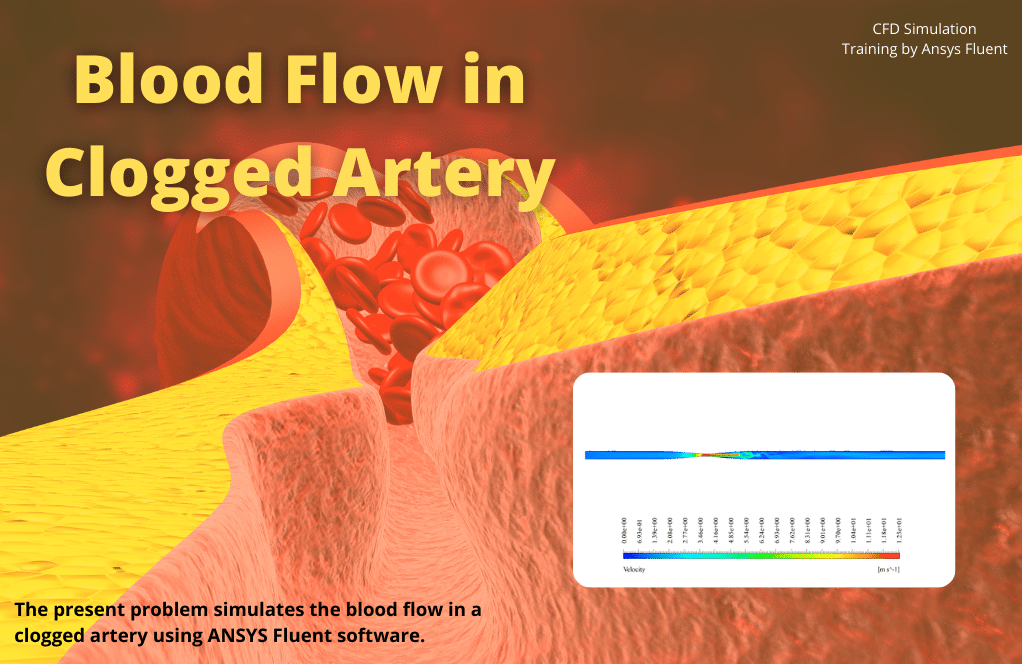
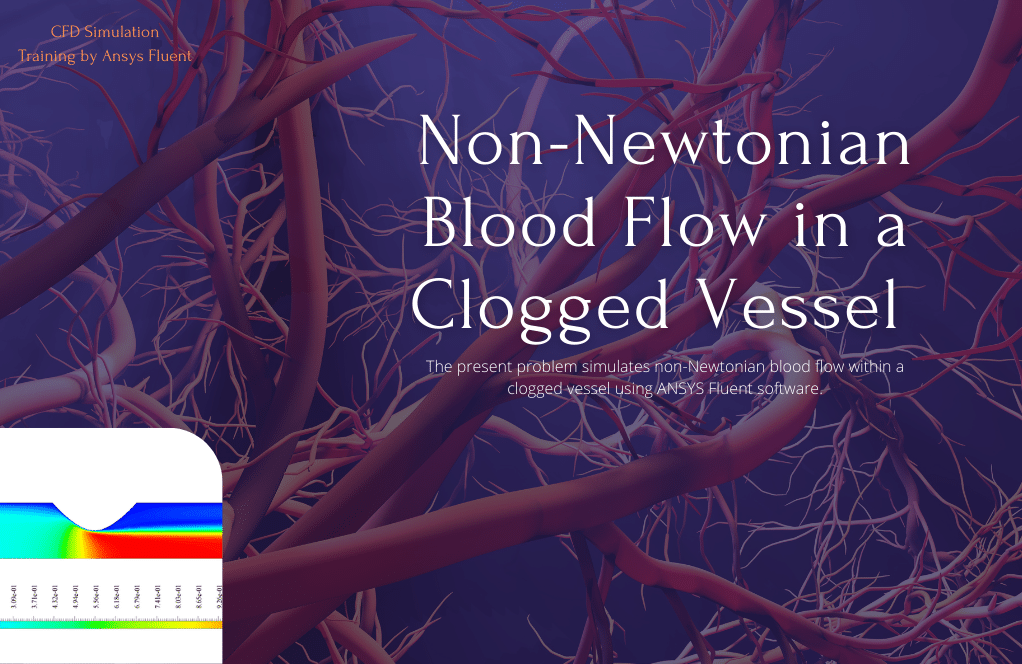
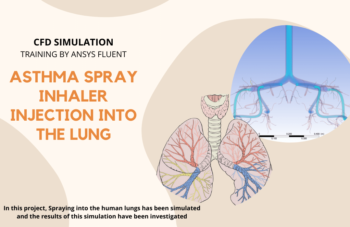
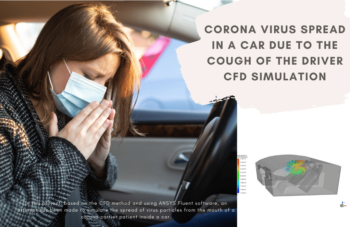
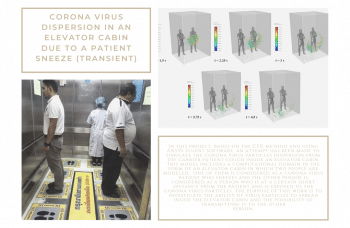
Mrs. Freeda Crist –
I’m impressed with the comprehensiveness and granularity of the Biomedical and Healthcare Training Package. The hands-on approach of starting with simple exercises and progressively tackling more complex simulations provides a strong learning curve for beginners. Top-grade educational material.
MR CFD Support –
Thank you for your kind words! We are enthusiastic to hear that our training package met your expectations with its detailed and practical learning path. Our aim is certainly to provide an engrossing learning experience for beginners in the biomedical field. Your satisfaction with our step-by-step approach is much appreciated!
Prof. Akeem Collins DDS –
The biomedical training package sounds fascinating! While I understand the package includes simulations involving blood flow and COVID-19 particle dynamics, does it also incorporate case studies or any form of patient data analysis to relate these simulations to actual medical outcomes?
MR CFD Support –
No, this package focuses on CFD in biomedical simulations and does not directly incorporate case studies or analyze patient data. It delivers a solid foundation for understanding fluid dynamics in the context of biomedical devices and healthcare scenarios. The practical exercises are tailored to beginners in CFD, bridging the gap between theory and application through simulation.
Ursula Stoltenberg I –
The training package for biomedical and healthcare is comprehensive for a beginner. Starting with basic blood flow simulations and ramping up to more complex scenarios involving cardiovascular health and COVID-19 particle dispersion is a logical progression. Are the training modules designed in sequential order to build upon each other or can they be tackled individually as standalone learning experiences?
MR CFD Support –
Each training module is designed to be self-contained to allow individuals to learn at their own pace and according to their own interests. However, there is a logical progression in difficulty and complexity from one module to the next, so beginners may find it beneficial to follow the sequence laid out to build a strong foundation and understanding in biomedical CFD simulations with ANSYS Fluent. Each module provides specific knowledge and skills that can also be applied independently to similar problems in the industry.
Thelma Fay –
I recently started the Biomedical and Healthcare Training Package and the simulations seem complex. Can someone with basic ANSYS Fluent knowledge complete these exercises successfully?
MR CFD Support –
Absolutely! The Biomedical and Healthcare Training Package has been carefully curated with the beginner in mind. Each exercise is designed to progress in difficulty, starting with simpler simulations and building up to more complex scenarios. Utilize the resources provided and take one step at a time, and you will be able to complete the exercises successfully. Should you need assistance at any point, the MR CFD team is here to support you.
Yazmin Williamson –
I’ve just started with the Biomedical and Healthcare Training Package and the material is incredible. The step-by-step guidance through different levels of complexity in simulations is perfect for beginners like me. Keep up the good work, MR CFD!
MR CFD Support –
Thank you for your kind words! We are thrilled to hear you’re finding the Biomedical and Healthcare Training Package beneficial and user-friendly. If there’s anything more we can help you with as you progress, don’t hesitate to ask. Best of luck with your learning journey!
Gene Harris –
I’ve just started with the included exercise on blood flow in clogged arteries, and I’m impressed with how well the concepts are laid out. It greatly aided my understanding of the obstruction’s impacts on blood flow dynamics. However, which fluid properties were adapted considering blood as a non-Newtonian fluid for these exercises, and could you provide a brief explanation on their significance in these simulations?
MR CFD Support –
For the exercises considering blood as a non-Newtonian fluid, properties like viscosity are not constant but vary depending on the shear rate. This is crucial for realistic simulation of blood since its viscosity changes under different flow conditions, which occurs naturally in our arteries and veins. Therefore, analysis with non-Newtonian fluid properties provides a more accurate representation of how blood behaves, particularly under abnormal circumstances such as in arteries with stenosis or blockages.
Austin Little –
I noticed several exercises mentioned in this package on biomechanical topics. Does the program assumes specific material properties for the blood in different states, like Non-Newtonian properties, and if so, how does it impact the simulations across exercises?
MR CFD Support –
Yes, the package details exercises that assume blood to have different material properties across simulations. It considers both Newtonian and Non-Newtonian properties where required. This affects the simulation results, especially regarding fluid behavior, as Non-Newtonian fluids show varying viscosity levels related to the shear rates. This alteration aims to make the simulation more realistic, particularly when simulating blood flow, as blood exhibits non-Newtonian characteristics under certain conditions.
Laney Daugherty –
The depth and variety of topics covered by this training package seem immense. From arterial occlusion to hyperthermia therapy – how does this package ensure that BEGINNER users are not overwhelmed, and can easily digest and understand such complex topics?
MR CFD Support –
The Biomedical and Healthcare Training Package is structured to take BEGINNER users through a gradually advancing complexity. The exercises begin with simpler simulations and step by step, introduce more challenging concepts. This ensures that users build their understanding and confidence as they progress. Additionally, the package likely includes thorough explanations, annotated steps, and possibly support, to ensure that users can follow along without feeling overwhelmed.
Mrs. Tracy Legros –
I’ve just started using the Biomedical and Healthcare Training Package, and it’s incredibly comprehensive for a beginner like me! I’m especially interested in learning about blood flow simulations in occluded arteries and was pleased to see it included in the first exercises. The practical examples enhance my learning, and the step-by-step guidance is excellent for grasping the concepts.
MR CFD Support –
Thank you for your positive feedback! We’re delighted to hear that you’re finding the Biomedical and Healthcare Training Package helpful as you embark on learning about blood flow simulations in occluded arteries. We’ve taken great care to tailor the package for beginners like yourself to ensure a smooth learning curve. If you have any further questions or need assistance as you progress, feel free to reach out. Happy learning!
Helene O’Keefe Sr. –
I’m impressed with this Biomedical and Healthcare Training Package! As a beginner in ANSYS Fluent, these practical exercises have been incredibly helpful for understanding the CFD applications in the medical field. It’s been valuable to see a range of simulations dealing with blood flow, coronavirus particle transmission, and even inhaler spray dynamics. The step-by-step approach in each learning product has given me solid foundational knowledge that I’m confident will support my future biomedical engineering projects.
MR CFD Support –
Thank you so much for your positive feedback! We’re truly delighted to hear that our training package has provided you with the foundational knowledge you need for your biomedical engineering endeavors. If you have any further questions or need additional support as you continue to explore CFD in the medical field, please don’t hesitate to reach out. Keep learning and all the best with your projects!
Anna Nicolas –
This biomedical and healthcare training package has provided a foundational understanding of CFD applications within my biomedical engineering field—a stupendous resource for beginners like me.
MR CFD Support –
Thank you for your positive feedback! We’re thrilled to hear that you found the package to be an effective resource for beginners, and it’s fantastic that it has helped you with your foundational understanding of CFD in biomedical engineering. If you have further inquiries or need more assistance, please do not hesitate to reach out.
Margarita Sawayn –
I started the biomedical training using the package for beginners and I must say, it has been an insightful journey! The step-by-step approach to blood flow simulation in arterial occlusion offered a lucid understanding of vascular health challenges. Also, I was particularly intrigued by the simulation of the transmission of coronavirus particles. It provided a vivid conceptualization of virus spread which is crucial given the current global awareness. The use of masks and social distancing were presented in a scientifically substantiated manner, which was highly informative. Fantastic resource for anyone venturing into biomedical engineering and CFD!
MR CFD Support –
Thank you for your wonderful review! We’re elated to hear that our Biomedical and Healthcare Training Package is providing valuable insights and helping you understand the complexities of biomedical simulations in ANSYS Fluent. Your feedback underscores our commitment to offering quality educational material that makes complex scientific concepts approachable. If you have any further questions or if there’s anything else we can help you learn, please don’t hesitate to reach out. Continue enjoying your learning journey!
Dr. Vilma Kuhn –
What are the different biomedical scenarios covered in this training package?
MR CFD Support –
The training package for BEGINNER ANSYS Fluent users in the biomedical and healthcare sector provides knowledge on various scenarios like blood flow in arterial occlusion, blood flow in clogged arteries, simulation of non-Newtonian pulsatile blood flow, assessment of airborne Coronavirus particle transmission and containment measures, air purification in a patient’s room considering virus particles, the trajectory of asthma spray inhaler particles, and hyperthermia therapy in tissues with cancerous tumors.
London Shields –
I’ve learned so much about CFD in the biomedical field using your training package! The practical exercises were well-structured and beginner-friendly.
MR CFD Support –
Thank you for your review! We’re thrilled to hear the training package met your needs as a beginner and gave you a strong foundation in biomedical CFD. If you need any further learning resources or support, please don’t hesitate to reach out.
Oswald Schowalter DVM –
This package has been a fantastic resource for understanding biomedical CFD applications! The step-by-step approach from simple to complex simulations has solidified the fundamentals so well for me.
MR CFD Support –
Thank you for your kind words! We are delighted to hear that our Biomedical and Healthcare Training Package has been instrumental in your CFD learning journey. Your feedback is greatly appreciated, and we wish you continued success in your future simulations and studies.
Kim Gerhold V –
The training package sounds comprehensive for a beginner. Could you please clarify if the blood modeling takes into account patient-specific data or is it generalized?
MR CFD Support –
The blood flow simulations provided in the training are generalized for educational purposes, with standard fluid properties used to represent blood. While patient-specific data can be incorporated into simulations, these exercises are designed to introduce beginners to basic principles, rather than focusing on individual patient parameters.
Myra Padberg –
I’m thrilled with how comprehensive the Biomedical and Healthcare Training Package is for Beginners. Despite being new to CFD simulations, I found the step-by-step guidance incredibly insightful, especially when it comes to the progression from simple scenarios to more complex situations involving the CORONA virus. The logical layout not only bolstered my understanding of fluid dynamics in biomedical contexts but also instilled confidence in handling different models. Kudos to MR CFD for creating an educationally rich experience!
MR CFD Support –
Thank you so much for your positive review! We’re delighted to hear that you’ve found our Biomedical and Healthcare Training Package rewarding and effective for your beginner’s journey into the world of CFD simulations in ANSYS Fluent. At MR CFD, we’re committed to providing intuitive learning experiences that make complex concepts accessible. Should you have further inquiries or needs as you continue learning, don’t hesitate to reach out. We’re here to support you!
Angeline Schimmel –
This biomedical and healthcare package seems comprehensive. I’m just wondering if it includes any support or guidance on setting up the UDFs for blood flow simulation in project number 4?
MR CFD Support –
Yes, this beginner package is designed to include guidance and support necessary for setting up all aspects of the simulations, including User-Defined Functions (UDF) for simulating pulsatile blood flow. The team at MR CFD Company ensures users will have the support they need to successfully complete the exercises.
Brandy Beatty –
Great mix of fundamental and complex simulations. The learning curve seems well-designed. Are there any prerequisites to start this package or can absolute beginners in CFD dive right in?
MR CFD Support –
Absolute beginners can indeed start with this package. It’s tailored to provide a step-by-step understanding, starting from basics like blood flow in simple arterial scenarios, gradually moving towards complex applications such as virus particle transmission and hyperthermia therapy simulations. Any required theoretical background or software skills will be part of the package.
Stanton Wolf –
The biomedical training package seems incredibly thorough! Are the exercises in the package based on real case studies or are they hypothetical scenarios?
MR CFD Support –
The exercises in this training package are designed to reflect real-world biomedical engineering scenarios and challenges. The simulations are based on both hypothetical case studies that illustrate common situations as well as upon real biomedical case studies to provide a practical learning experience. Real-world parameters and conditions are incorporated wherever possible to simulate realistic outcomes and give learners a better understanding of biomedical CFD applications.
Lindsay Bode DVM –
Wonderful training package! Could you specify if these exercises cover the spectrum from basic CFD concepts to advanced topics entirely suitable for a beginner, and how well does it bridge to intermediate-level CFD knowledge?
MR CFD Support –
Thank you for your kind words! This training package is tailored for beginners which means it introduces basic CFD concepts and progressively tackles more complex scenarios within the biomedical field. Each exercise builds upon the last, ensuring that by the time a beginner has completed the package, they will have a solid foundation and should be ready to move onto intermediate-level CFD problems with confidence.
Miss Dana Olson Sr. –
I just completed the Biomedical and Healthcare Training Package, and the mix of practical exercises was impressive. Starting from the basics with arterial occlusion simulations and progressing through more complex COVID-19 particle transmission studies, each exercise consolidated my understanding of applying CFD in biomedical contexts. The final cap on hyperthermia therapy was particularly enlightening—a challenging yet exciting topic. Very comprehensive beginner’s package for any healthcare and biomedical engineer eager to grasp CFD’s vital role in this field.
MR CFD Support –
Thank you so much for taking the time to leave this excellent review. We are thrilled that you found the Biomedical and Healthcare Training Package educational and comprehensive. It’s great to hear that the progression from basic exercises to complex simulations was helpful in enhancing your understanding of CFD applications in the biomedical field. We appreciate your feedback and are glad to facilitate learning experiences that encourage your professional growth. If you have any more insights or need further assistance as you apply what you have learned, please feel free to reach out.
Neal Becker Jr. –
The Biomedical and Healthcare Training Package was truly informative; clear illustrations of blood flow simulations helped me understand cardiovascular subjects, and the graphical interface in the provided exercises was intuitive. Especially beneficial were the simulations of aerosol dispersion related to COVID-19, offering a practical application for current healthcare challenges. I look forward to exploring more sophisticated scenarios with these foundations.
MR CFD Support –
We greatly appreciate your thoughtful review! It’s rewarding to hear that our Biomedical and Healthcare Training Package has offered you helpful insights into cardiovascular studies, as well as real-world applications in these challenging times. Your feedback motivates us to continue delivering high-quality and practical learning products. If you ever decide to dive into more advanced simulations, we’re here to support your journey. Thank you for choosing MR CFD.
Mrs. Leann Beier V –
This training package completely blew me away. With such a detailed approach, beginning from the basics of arterial occlusion to the complex simulations of COVID-19 virus transmission and prevention measures, I gained not only technical expertise in using ANSYS Fluent but also a profound understanding of biomedical applications in CFD. The step-by-step guidance was instrumental in easing into each exercise. The package effectively uses real-world medical scenarios, ensuring that the learning experience is practical and relevant.
MR CFD Support –
We greatly appreciate your kind words and are thrilled to hear that our Biomedical and Healthcare Training Package for Beginners met your expectations. It’s wonderful to see that you found the real-world medical scenarios and stepped guidance invaluable. Thank you for choosing our ANSYS Fluent training package, and we look forward to continuing to support your journey in learning and applying CFD in biomedical engineering.
Gilda Nikolaus DVM –
I’ve just started using this training package and it’s fantastic! The progression from simple to complex models has given me a solid foundation in biomedical CFD analysis. The use of ANSYS Fluent has been demystified through hands-on experience. I’ve been able to understand blood flow dynamics and am eager to apply the concepts to coronavirus particle simulation. Amazing resources for beginners like me!
MR CFD Support –
Thank you for your kind words! We’re thrilled that you find the Biomedical and Healthcare Training Package to be an excellent resource for learning CFD simulation using ANSYS Fluent. Your enthusiasm to apply these concepts to various simulations, including those related to the coronavirus, is encouraging to hear. We wish you continued success in your learning journey. If you have any questions or require further assistance, we’re here to help!
Raymundo Armstrong DDS –
I found the training package very comprehensive and helpful! Could you let me know if there are any prerequisites I need to satisfy before I can start learning with these modules?
MR CFD Support –
We are delighted to hear that you find our training package comprehensive! As a
Dr. Petra Runolfsson III –
I was really impressed by the biomedical engineering simulations included in this training package. The simulations ranging from blood flow in arteries to hyperthermia therapy provided comprehensive knowledge for beginners like me. The examples are practical and relevant, helping to bridge the gap between theory and application.
MR CFD Support –
Thank you so much for your feedback! We’re delighted to hear that you found the variety and practical aspects of our Biomedical and Healthcare Training Package beneficial to your learning experience. Continue exploring and applying your knowledge, and don’t hesitate to reach out to us for any further support!
Jerad Beer I –
I was pleasantly surprised by how fantastic the Biomedical and Healthcare Training Package worked for my learning curve as a beginner in ANSYS Fluent. The topics covered, from arterial occlusion to hyperthermia therapy simulations, provided comprehensive insights and were quite practical. I found these exercises particularly helpful!
MR CFD Support –
We’re thrilled to hear that the Biomedical and Healthcare Training Package has exceeded your expectations as a beginner in ANSYS Fluent and has been instrumental in your learning process. Thank you for choosing our training products, and we’re here to support your continuing growth in the field of CFD!
Nichole Becker –
The comprehensive nature of this training package is commendable. Beginning with blood flow simulations related to arterial issues and gradually escalating to the intricacies of simulating virus particle dispersion and the effects of masks is impressive. Moreover, the inclusion of exercises that encompass hyperthermia therapy and asthma spray dynamics demonstrates a mindful incorporation of both macro and micro aspects of biomedical phenomena through CFD. This package is a substantial resource for newcomers to the field.
MR CFD Support –
We appreciate your detailed review highlighting the broad spectrum covered in our Biomedical and Healthcare Training Package. It is great to hear how well you perceive the gradual skill development and its relevance to real-world biomedical challenges. Thank you for choosing and recommending our carefully curated set of learning tools aimed at empowering beginners in applying ANSYS Fluent to the life sciences industry. We hope you continue to find value in our educational offerings.